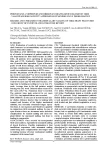Additive stabilisation of the elbow using external fixator in pediatric skeletal traumatology
Authors:
Tomáš Pešl; Petr Havránek
Authors‘ workplace:
Klinika dětské chirurgie a traumatologie 3. LF UK a Centrum dětské traumatologie, FTN Praha, Krč
Dept. of Pediatric and Trauma Surgery
; rd Faculty of Medicine Charles University, Prague, CZ
3
Published in:
Úraz chir. 16., 2008, č.3
Overview
Background:
External fixation has been used for primary stabilisation of the distal humeral supracondylar and intercondylar fractures in children by several authors. In our department closed reduction and internal fixation for stabilisation of these distal humeral fractures in children is used as a first choice, external fixation is not used primarily. The authors present a cohort of pediatric patients in which the additive stabilisation of the elbow using the external fixation makes the management of the distal humeral fracture in the complex upper extremity injury possible.
Patients:
During the period of three years we treated four children with complex injury of the arm including the supracondylar or intercondylar fracture of the humerus. In these patients the additive stabilisation of the elbow by external fixator was used after the primary internal fixation was performed. We used the unilateral fixator type.
Results:
There were two boys with supracondylar fracture and two boys with intercondylar fracture of the distal humerus. The first boy with the compound fracture of the wrist (Tscherne type O3) and supracondylar fracture of the humerus was healed without any sequels; in the second boy with the compound fracture of the distal humerus (Tscherne type O3) with supracondylar fracture of the humerus the nonunion of the fragments developed. In the two boys with intercondylar fracture was found complete bone healing with limited ROM. The follow up is from two years to six month.
Conclusion:
We don’t use the method of external fixation for a primary stabilisation of the supracondylar or intercondylar fractures of the humerus in children. However, in case of the complex injury of the upper extremity we found it very helpful for injury management.
Key words:
humerus, supracondylar fracture, child, external fixation.
Sources
1. DEUEL, C. R., SCHEMITSCH, E. H. et al. Use of a hinged external fixator to provide additional stabilisation for fractures of distal humerus. J Orthop Trauma. 2007, 21, 323–329.
2. GUGENHEIM, J. J. jr. The Ilizarov fixator for pediatric and adolescent supracondylar fracture variants. J Pediatr Orthop. 2000, 20, 177–182.
3. HAVRÁNEK, P. Děstké zlomeniny. 1. vyd. Praha: Corvus 1991.
4. HAVRÁNEK, P., HÁJKOVÁ, H. Příspěvek k léčbě suprakondylických zlomenin humeru u dětí. Acta Chir Orthop Traumatol Čech. 1984, 51, 65–68.
5. HAVRÁNEK, P., PEŠL, T. Užití elastické stabilní nitrodřeňové osteosyntézy u dětí v netypických indikacích. Acta Chir Orthop Traumatol Čech. 2002, 69, 73–78.
6. LIGIER, N. L´embrochade elastique stable á foyer fermé en traumatologie infantile. Chir Pédiatr. 1983, 24, 383–385.
7. MÉTAIZEAU, J. P. L´ostéosynthése chez l´enfant- techniques et indications. Rev chirorthop. 1983, 69, 495–511.
8. SCHMITTENBECHER, P. Radial external fixation. AO Speciality Course – Pediatric. Davos 6th-7th December 2006.
9. TALLER, S. Použití zevního fixátoru v léčbě suprakondylických zlomenin humeru u dětí. Acta Chir Orthop Traumatol čech. 1986, 53, 508–514.
Labels
Surgery Traumatology Trauma surgeryArticle was published in
Trauma Surgery

2008 Issue 3
Most read in this issue
- Reamed and Unreamed Intramedullary Nailing of Tibia Shaft Fractures - our Group of Patients and Literature Review
- National Children´s Trauma Register
- Additive stabilisation of the elbow using external fixator in pediatric skeletal traumatology
- ASEPSIS – POINT OF CONSCIENCE AND PROFESSIONALISM
